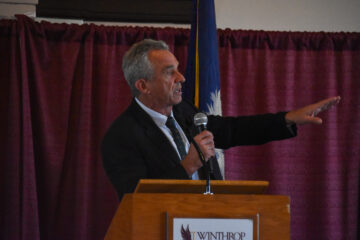If you thought Valentine’s Day is nothing more than sending chocolate hearts and casual dates with your loved ones, then you’d be mistaken. Before the modern day concepts of Valentine’s Day were prevalent, there are roots of this holiday that can be traced back to ancient Rome and the customs of Medieval Europe.
According to History.com, the earliest holiday that occurred around Valentine’s Day was celebrated with a pagan ceremony in Ancient Rome called Lupercalia. Celebrated from Feb. 13-15, the festival was one of fertility, where Romans would sacrifice a goat and dog in the cave supposedly where the founders of Rome, Romulus and Remus were born, along with a matchmaking ceremony where men would pick a name of a woman from an urn that would pair off into couples. A strange custom of the festival was that women would take the hide of the goat and parade around being gently tapped or whipped in town, which they believed it would make them more fertile.
The name of Valentine’s Day originated from one of the legends of a Christian martyr in Ancient Rome named Valentinus or Valentine. Valentine was a Christian priest who lived in the time of Roman Emperor Claudius II, who banned marriages for young men believing they would make better soldiers if they were single. The priest wedded young couples in secret, but was eventually discovered and executed by the Roman authorities. This action would cause the Catholic Church to canonize Valentine as a Saint in the church, and ban the holiday of Lupercalia in the 5th century, replacing it with St. Valentine’s Day on Feb. 14.
In France and England, the holiday is called a day of love to coincide with the start of the mating season of birds. Most Valentine’s Day greetings were spoken, with the first written Valentine’s Day greetings dating back to the 1400s. One of the first Valentine’s Day messages was sent from Charles, Duke of Orleans to his wife while we was captured in the Battle of Agincourt. Another report of the first written Valentine’s Day message was of the English King Henry V who hired a writer, named John Lydgate, to write a message to Catherine of Valois.
By the 17th century, the holiday became popular in Great Britain. In the middle of the 18th century and 1900s, people of various social classes would exchange handwritten notes and gifts of affection, later having printed notes of love. This would also be a popular tradition in America during the 1700s, which would later be popularized by Esther A. Howland. Howland was famous as the “Mother of the Valentine,” who created a mass reduced Valentine’s Day cards with laces, real ribbons and colorful pictures decorated on the cards.
Overall, it’s interesting to see the events and previous celebrations that would inspire the modern day Valentine’s Day we know today. You wouldn’t expect a holiday about hearts to have originated from pagan ceremonies of fertility and the origins of spoken valentines before mass printed ones. Maybe it would impress your friends or have them reflect on how Valentine’s Day could be weirder than it actually is.




